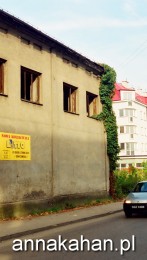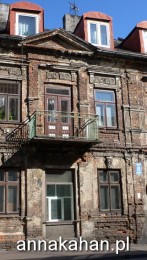[Jatkowa Street]
Jatkowa Street is currently called Czerwony Krzyż Street. It was renamed around 1924.
We turn to Czerwony Krzyż Street and get to its intersection with Browarna Street.
Anna Kahan lived with her family in the house at 9 Jatkowa Street. Currently, here there is a new building, which is located at the corner of Czerwony Krzyż and Browarna Streets. Every Friday morning, before breakfast, she went to the bakery to buy challahs and sweet buns. It was her duty that day. She probably bought challahs at the bakery located on the same street. There were several bakeries to choose from D. Flam (2 Jatkowa Street), J. Piekarz (No. 4), R. Słuszna (No. 5) and E. Rak located at number 10. It was also close to E. Rynecka bakery at 7 Browarna Street.
Her father, a very religious man, also did not have too far to the butchers’ prayer house, a temple associated with his profession. It was located a bit further north of the house, at the next intersection of Jatkowa and Prospektowa Streets (currently Mieczysław Asłanowicz Street). The synagogue stood on the same odd side of the street. In 1999, the Jewish Community of Warsaw decided to demolish it.
In the same year, from the landscape of the city disappeared the last stone-paved gutter in Podlasie. This part of the old infrastructure was located on the western edge of Pałacowa Street (currently Tadeusz Kościuszko Street). It gives an idea of the sanitary conditions in the city at the time described by our diarist.
The house of Wiktor Miłkowski, located at Alejowa Street (currently Kiliński Street) was the first one that was equipped with all the amenities without which we could not imagine life now. It had its own water intake, a pump with an internal combustion engine, a central heating system, a bathroom, a toilet, and a septic tank. The house was built between 1900 and 1906, from profits made by his Factory of Agricultural Machines and Tools that was located at current 16 Kiliński Street. In Anna’s time, it was the only house in the city with such a high standard of sanitation.
So, what were the living conditions of other residents of Siedlce? The author of the Diary answers this question on June 27, 1915,
“Almost daily, inspectors come around now to enforce the sanitary laws. Many people have been fined, but at least our street looks cleaner than before. However, I think that the order not to pour slops into the gutter during the day is no good. In this heat to keep them in a bucket in the house all day can really cause an epidemic. It’s about time we had sewers like in Warsaw. “
We turn right into the park.
After coming to Konarski Street, in front of us we see the Palace building, on its right side there is a seat of The State Archive in Siedlce. This building housed the Russian Gymnasium for Girls (a secondary school). The entrance to the school was located at Bishop Ignacy Świrski Street, directly opposite the entrance to the courtyard of the post office.




